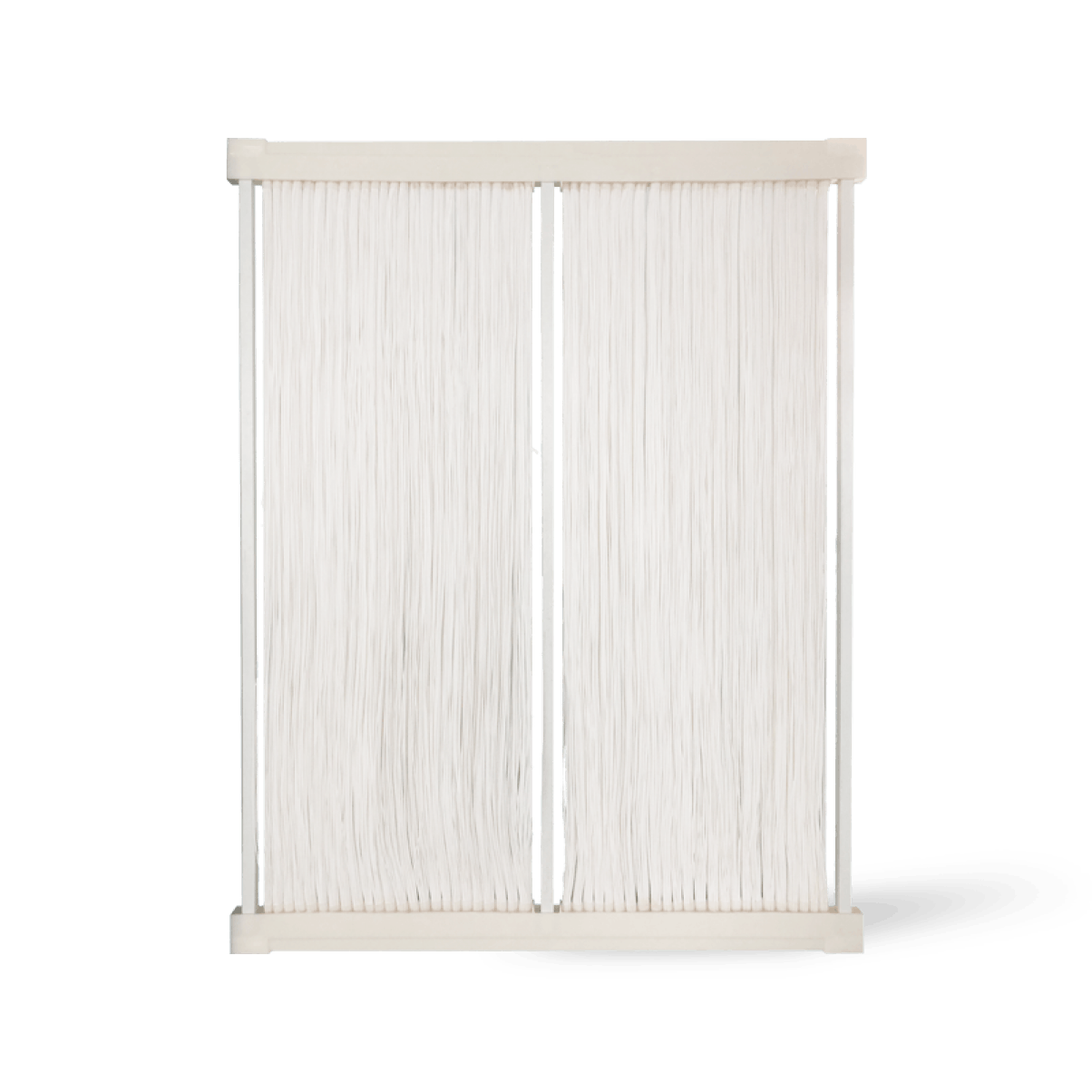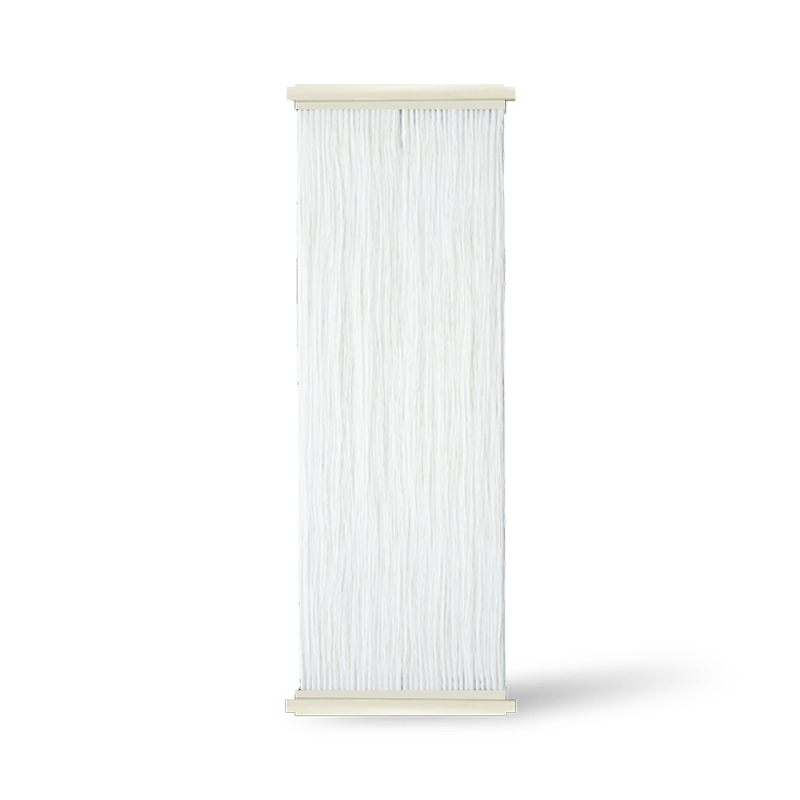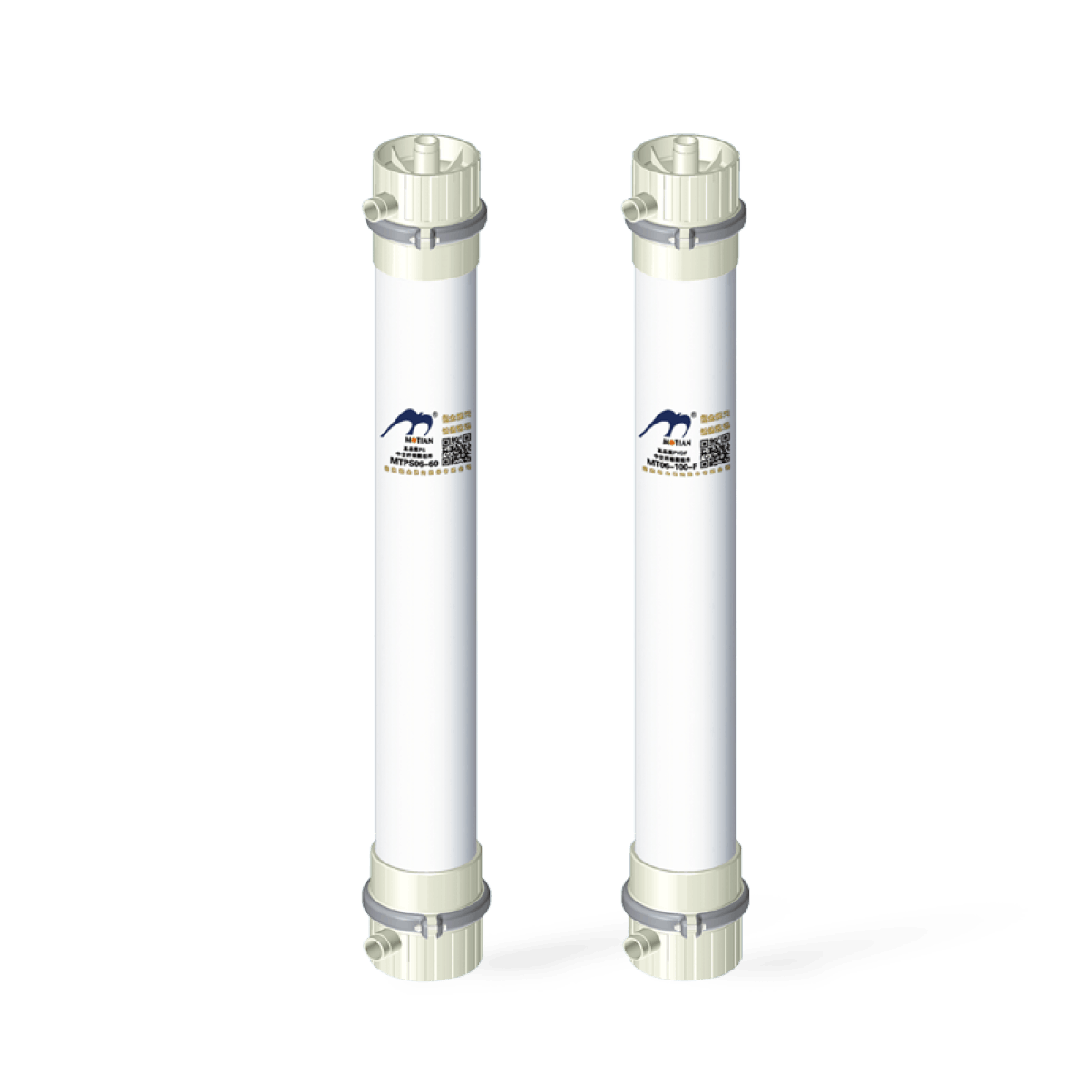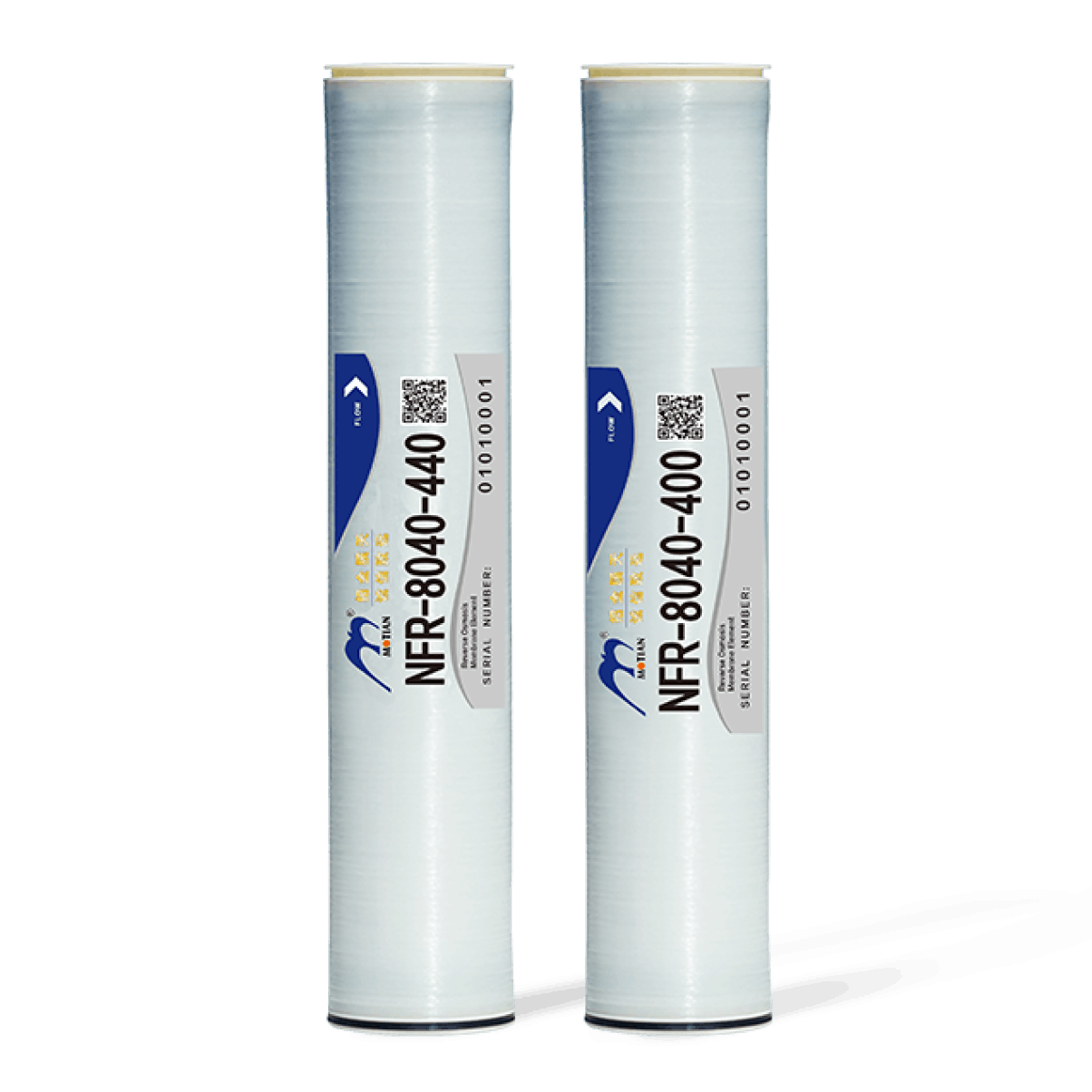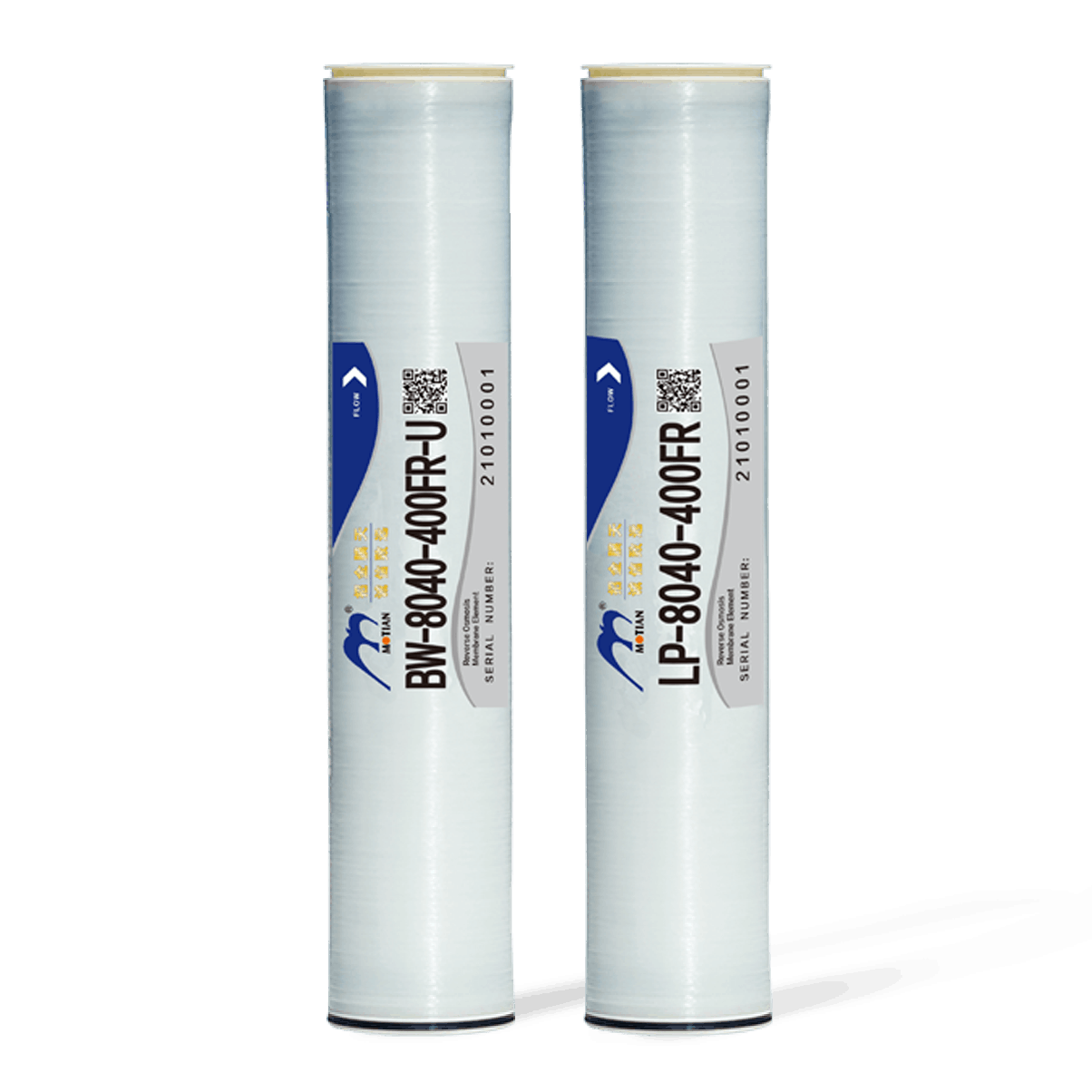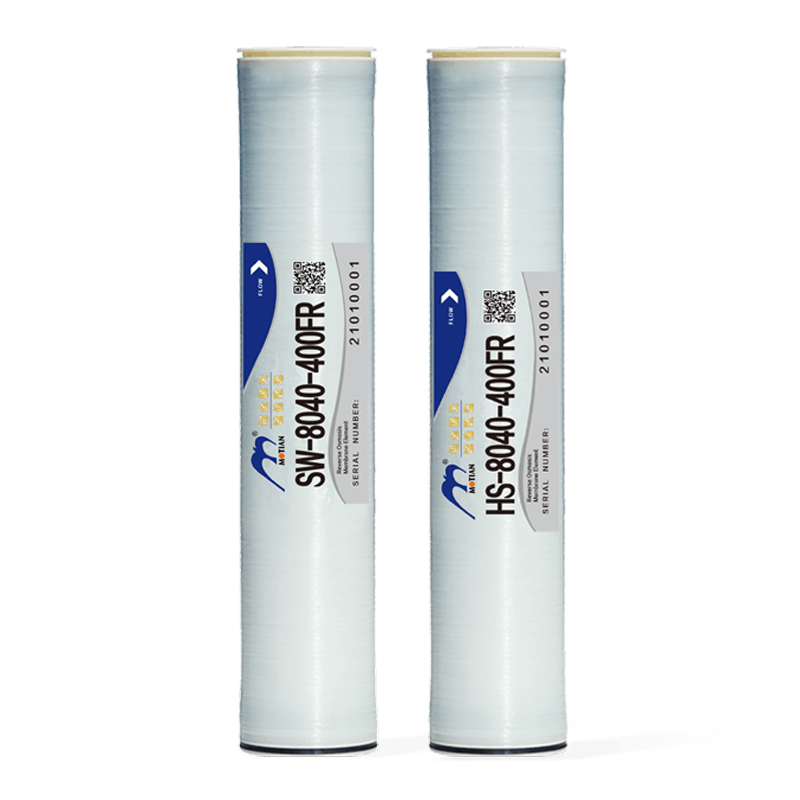 High-performance membrane equipment integrated design technology
High-performance membrane equipment integrated design technology
Process flow one: coagulation + precipitation + filter + ultrafiltration
· Coagulation and precipitation: Raw water first undergoes coagulation treatment, using chemicals (such as polymerised alumina) to react with fine suspended particles and colloidal ions in the water, causing them to destabilise and aggregate to form larger flocs, and the coagulated water enters the sedimentation tank for precipitation. Sedimentation is the use of gravity to make the flocs in the water sink to the bottom of the pool, and the sediment is removed by means of sludge discharge, thus further improving the water quality.
· Filter: After settling, the water enters the filter system. The filter physically removes the remaining suspended matter and some dissolved substances in the water, such as bacteria and viruses, to ensure further purification of the water. Filters can be selected from activated carbon, multi-media filters or other types of filtration equipment.
· Ultrafiltration: Filtered water enters an ultrafiltration system. Ultrafiltration is a technology that uses pressure-driven membrane separation technology to retain substances with molecular weights greater than a certain range, while allowing water and small molecules to pass through. The filtered water enters the ultrafiltration system, which is capable of removing bacteria, viruses, and large organic molecules from the water to improve water quality.
To sum up, after the raw water has gone through a series of treatment steps such as coagulation, precipitation, filter and ultrafiltration, it can effectively remove pollutants in the water, and also reduce the cost of sewage disposal of enterprises and realise the recycling of water resources. The process is suitable for industrial water with low salinity requirements but high requirements for suspended solids in water, such as textile, paper and other industries.
Process flow two: heat exchanger + flocculant dosing device + scale inhibitor dosing device + submerged ultrafiltration + primary reverse osmosis
· Heat exchanger: Firstly, the raw water is initially heated or cooled through the heat exchanger to suit the operating temperature requirements of the subsequent treatment equipment.
· Dosing device: through the flocculant dosing device and scale inhibitor dosing device, it can remove the suspended matters and impurities in the water, prevent the formation of hard-to-remove scale in the submerged ultrafiltration process, and ensure the cleanliness of water quality and efficient operation of the system.
· Submerged ultrafiltration: Raw water enters the submerged ultrafiltration system, the submerged ultrafiltration membrane technology has strong pollution resistance, the front end does not need to set up a multi-media filter, can effectively remove impurities in the water, such as microorganisms and bacteria, etc., and at the same time help to reduce the electrical conductivity of the water, for the subsequent reverse osmosis treatment to create better conditions.
· First-stage reverse osmosis: after submerged ultrafiltration treatment of water into the first-stage reverse osmosis system, the first-stage reverse osmosis is the use of semi-permeable membrane selective permeability, to remove most of the ions and organic matter in the water, so as to obtain a higher quality of water.
In summary, the whole process of raw water passing through a heat exchanger to a dosing unit to immersion ultrafiltration and reverse osmosis is a complete process from pre-treatment to deep purification to final softening or deionisation, designed to maximise water quality. This series of treatment steps effectively removes suspended solids, colloids, organics and dissolved salts from the water, ultimately providing high quality water. The process is suitable for industrial water applications that do not require high salt content and are capable of heat transfer, such as circulating water cooling.
Process three: coagulation + precipitation + filter + ultrafiltration + two-stage reverse osmosis + ion exchange
· Coagulation and Sedimentation: River water is coagulated by adding coagulants to the water using flocculation and bridging between the coagulant and the impurities in the water to generate larger particles of sediment for removal. This step effectively removes suspended and some colloidal substances from the water.
· Filter: After coagulation and precipitation treatment, the water enters the filter. The high-efficiency fibre filter can further remove fine particles and organic matter in the water and improve the water quality.
· Ultrafiltration: Ultrafiltration is a new, efficient and clean water treatment technology, through the selective permeability of the ultrafiltration membrane to retain impurities in the water, so as to achieve the purpose of water purification. The filtered water enters the ultrafiltration system, which is able to remove bacteria, viruses, macromolecules and organic matter in the water to improve water quality.
· Two-stage reverse osmosis: after ultrafiltration treatment of water into the reverse osmosis system, reverse osmosis is through high-pressure water molecules through the semi-permeable membrane, while preventing the passage of larger molecules and particles through the material, so as to further improve the quality of water, the two-stage reverse osmosis can remove most of the inorganic salts in the water and other dissolved substances, the output of close to the pure water of the product water.
· Ion exchange: After two-stage reverse osmosis treatment of water into the ion exchange system, through the ion exchange resin to remove the anion and cation in the water, such as calcium, magnesium and other hardness ions, so as to soften the water and remove more impurities, and ultimately get the boiler suitable for the use of softened water.
In summary, the raw water through coagulation and precipitation, filters, ultrafiltration, two-stage reverse osmosis and ion exchange a series of treatment processes, and ultimately get the boiler suitable for the use of high-quality water. This series of processes can not only effectively remove impurities and pollutants in the water, can soften the water quality through ion exchange, to meet the boiler and other equipment on the strict requirements of water quality. This process is suitable for industrial water with high salt content requirements, such as boiler make-up water and other industries.
Process four: coagulation precipitation + activated carbon filter + ultrafiltration + two-stage reverse osmosis + EDI + ultraviolet lamp steriliser
· Coagulation and Sedimentation: River water is coagulated by adding coagulants to the water using flocculation and bridging between the coagulant and the impurities in the water to generate larger particles of sediment for removal. This step effectively removes suspended and some colloidal substances from the water.
· Filter: After coagulation and precipitation treatment, the water enters the filter. The high-efficiency fibre filter can further remove fine particles and organic matter in the water and improve the water quality.
· Ultrafiltration: Ultrafiltration is a new, efficient and clean water treatment technology, through the selective permeability of the ultrafiltration membrane to retain impurities in the water, so as to achieve the purpose of water purification. The filtered water enters the ultrafiltration system, which is able to remove bacteria, viruses, macromolecules and organic matter in the water to improve water quality.
· Two-stage reverse osmosis: after ultrafiltration treatment of water into the reverse osmosis system, reverse osmosis is through high-pressure water molecules through the semi-permeable membrane, while preventing the passage of larger molecules and particles through the material, so as to further improve the quality of water, the two-stage reverse osmosis can remove most of the inorganic salts in the water and other dissolved substances, the output of close to the pure water of the product water.
· Ion exchange: After two-stage reverse osmosis treatment of water into the ion exchange system, through the ion exchange resin to remove the anion and cation in the water, such as calcium, magnesium and other hardness ions, so as to soften the water and remove more impurities, and ultimately get the boiler suitable for the use of softened water.
In summary, the raw water through coagulation and precipitation, filters, ultrafiltration, two-stage reverse osmosis and ion exchange a series of treatment processes, and ultimately get the boiler suitable for the use of high-quality water. This series of processes can not only effectively remove impurities and pollutants in the water, can soften the water quality through ion exchange, to meet the boiler and other equipment on the strict requirements of water quality. This process is suitable for industrial water with high salt content requirements, such as boiler make-up water and other industries.
Introduction to Brackish Water and Desalination Processes
Reverse osmosis membrane method and low-temperature multi-effect distillation method are currently common desalination processes, and the process performance comparison of the two is shown in Table 1. Low-temperature multi-effect distillation method has the advantages of low seawater pretreatment requirements, low investment costs and operating costs, and the advantages of reverse osmosis membrane method are reflected in the seawater utilisation rate, energy consumption and variable operating conditions. From the economic advantages presented by the two processes in actual engineering projects, reverse osmosis method has a tendency to come later.
Process route one: pretreatment + ultrafiltration + reverse osmosis + post-treatment
The process is suitable for desalination of seawater with a salt content of 30,000mg/L or more.
Depending on the water quality of the raw water and water requirements, the pretreatment system can take the form of coagulation and precipitation and sand filtration, which can effectively remove impurities such as colloids, suspended solids, tiny particles and bacteria in the water. Through the subsequent increase of ultrafiltration device, can make the water quality further destabilisation, for reverse osmosis to provide high-quality pre-treatment water. In the reverse osmosis system part can be used Zhaogin Membrane Tian SW seawater reverse osmosis membrane element, the membrane element has a very high rate of desalination (99.7%) and stable system operation characteristics. Afterwards, in order to improve the pH and water quality of the reverse osmosis product water, add appropriate amount of carbon dioxide, saturated lime water and other filter media after the reverse osmosis process to post-treat the desalinated water, so as to make it meet the requirements of the national ‘Standard for Drinking Water’.
Process route two: pretreatment + ultrafiltration + primary reverse osmosis + secondary reverse osmosis
The process is suitable for desalination of seawater with a salt content of 30,000mg/L or more.
The seawater after coagulation and sedimentation and sand filtration is then fed into the ultrafiltration device, which can effectively remove impurities such as colloids, solid particles, germs, etc., and prevent large molecules or solutes from entering the reverse osmosis system. The process adopts two stages of reverse osmosis, in which the first stage of reverse osmosis can adopt Zhaogin Membrane Tian SW seawater reverse osmosis membrane elements, which can achieve the purpose of high desalination, combined with Zhaogin Membrane Tian XLP very low pressure reverse osmosis membrane elements (150psi) for deep treatment can bring a higher water yield while significantly reducing the operating costs to meet the needs of the industrial water.
Process route three: pre-treatment + reverse osmosis
The process is suitable for desalination of surface water, groundwater and other water sources with a salt content of 10,000mg/L or less.
Pre-treatment system depending on the water quality of the raw water and water requirements, can take the coagulation and precipitation and multi-media filtration to achieve efficient removal of colloids, suspended solids, tiny particles and bacteria and other impurities in the water to reduce the turbidity of the water. In the reverse osmosis system part can use Zhaojin Membrane Tian FR anti-pollution reverse osmosis membrane elements. The membrane element has the characteristics of low operating pressure, high water yield, good desalination performance and good pollution resistance, etc., which can effectively improve the production efficiency while reducing the cleaning cost.
Process route one: AAOAO + MBR process
The five-stage Batenfurt process (AAOAO) creates an environment in which the phosphorus-polymerising bacteria, nitrifying bacteria and denitrifying bacteria each have their own suitable growth environment, and improves the proportion and activity of phosphorus-polymerising bacteria, nitrifying bacteria and denitrifying bacteria in the activated sludge, so as to achieve high efficiency of phosphorus removal and denitrification. The five-section Batenfu is suitable for various scales of urban sewage treatment plant, is the development and improvement of A2O process, with obvious advanced and superiority.
MBR process combines membrane separation technology with biological treatment technology to achieve the separation of sludge residence time and hydraulic residence time, which greatly improves the solid-liquid separation efficiency, and improves the biochemical reaction rate due to the increase in the concentration of activated sludge in the aeration tank and the emergence of effective bacteria (especially the dominant group of bacteria) in the sludge.
This process route combines the five-stage Barton Fu process (AAOAO) with the MBR process, which can give greater play to the biochemical effect of microorganisms and the role of membrane separation, and COD, ammonia nitrogen, TN, TP in the wastewater can be effectively removed.
Process route two: A2O + flocculation and sedimentation + V-filter process
The AAO process combines the traditional activated sludge process, biological nitrification and denitrification process and biological phosphorus removal process, which can effectively remove ammonia nitrogen and organic matter in wastewater at the same time. Through the subsequent increase of coagulation and sedimentation unit, it can further destabilise the suspended matter in the water and remove the total phosphorus in the water at the same time, and through the interception and filtration effect of the filter media in the V-shape filter tank, it can further reduce the particles and total phosphorus in the water, so as to realise the effluent discharge to meet the standard.
Process route three: AAOAO + denitrification contact tank + high density sedimentation tank + fibre rotor
This process route can be used for the removal of ammonia and total nitrogen in alpine areas. By changing the functions of the ‘regulating tank and A tank’, it operates as a regulating tank in summer when the water temperature is high and the nitrogen concentration is low to regulate the water quantity, and as an anoxic tank in winter when the water temperature is low and the nitrogen concentration is high to remove the total nitrogen. In the deep treatment stage, carbon source is added and MBBR packing is used for denitrification reaction to further remove total nitrogen; coagulant and flocculant are added to complete efficient sedimentation by using refluxing sludge; and suspended matters in the fibre rotary filters are further intercepted in the water to meet the standard discharge.
Process route four: anoxic tank + oxidation ditch + secondary sedimentation tank + MBR tank (+ ultrafiltration + reverse osmosis)
This process route can be used for part of the municipal sewage water reuse, the rest of the sewage discharge standards. The use of anoxic tank and oxidation ditch biochemical removal of COD, ammonia nitrogen, total nitrogen in the water, the use of chemical phosphorus removal to remove phosphorus in the water, in the MBR membrane interception, to ensure that the effluent COD, ammonia nitrogen, total nitrogen, total phosphorus is in the very low value. Part of the MBR produced water can enter the ultrafiltration, reverse osmosis system for water reuse, reverse osmosis produced water concentrate and the rest of the MBR membrane produced water mixed to meet the discharge requirements.
Process route I: pre-treated wastewater - immersion ultrafiltration - disinfection
After the final sedimentation tank + ozone treatment by the sewage treatment station, the sewage enters the submerged ultrafiltration; submerged ultrafiltration membrane is placed in the pool, the inlet channel is completely open, and the water is pumped under negative pressure from the outside to the inside, with pressure as the driving force, and the membrane pores are used to physically separate the liquids, which can effectively remove the suspended solids in the water, turbidity, etc.; Zhaogin Membrane Days submerged ultrafiltration membrane has excellent material of the membrane filaments, and the preparation process is advanced; it has narrow distribution of the apertures, and High filtration precision; good chemical resistance; good hydrophilicity, stronger anti-pollution ability; occupies an area to save; strong impact resistance, etc., and finally disinfection of submerged ultrafiltration effluent to remove bacteria, microorganisms, etc., in the wastewater; this process can directly cope with the poor quality of influent water and the water to the salt content of the water is not overly high requirements of the situation, the submerged ultrafiltration can directly cope with the influent water with high suspensions, not special pretreatment requirements. Impact on the pretreatment requirements are not particularly strict.
Process route II: pre-treated wastewater - multi-media filter - security filter - ultrafiltration
After the biochemical treatment of sewage in the second sedimentation tank mud-water separation, into the multi-media filter to further filter the concentration of suspended solids in sewage, colloids, sediment and other substances, to ensure that the ultrafiltration unit of the water requirements; at the same time in order to ensure that the ultrafiltration membrane for a long time to ensure the stability of the operation of the ultrafiltration membrane, in the sewage into the ultrafiltration membrane before the addition of security filters, to avoid the multi-media filtration system to avoid carrying large particles of substances in the treated water scratching or plugging of the ultrafiltration membrane components. This process can effectively reduce the suspended solids, bacteria, microorganisms and colloidal aluminium, colloidal iron and other substances in the wastewater, which can be applied to the purification of industrial water that does not require high salinity, and compared with submerged ultrafiltration, this process produces more stable water with higher water quality.
Process route III: Sewage - manganese sand filter - security filter - ultrafiltration - security filter - reverse osmosis
As the production sewage reuse system of paper making, textile, printing and dyeing, chemical and leather enterprises, iron and manganese in the sewage exist almost simultaneously, and when the sewage contains high amount of iron and manganese, it will grow iron bacteria and rust spots, blocking the pipeline, and if it cannot be effectively removed, it will reduce the quality of industrial products; manganese sand filter uses manganese sand as the filtration medium, and achieves the purpose of water purification by the interception, settlement and adsorption effect of the filter media; The filter media can effectively remove suspended solids, colloids, sediment, rust and other substances in the water, with high strength, long service life, large treatment flow, stable and reliable water quality and other significant advantages; manganese sand filter water and then enter the ultrafiltration treatment of suspended solids, bacteria, microorganisms in the wastewater, as well as colloidal aluminium, colloidal iron, and other substances to further remove; in addition to the sewage by the pre-treatment of the ultrafiltration and reverse osmosis and the concentration of the water hooked up to the mixing This process can be applied to the deep treatment of industrial water, sewage reuse and other fields.
Process route IV: Pre-treated wastewater - security filter - ultrafiltration - security filter - reverse osmosis
After pre-treatment of sewage water quality is good and stable, after the security filter filtration directly into the ultrafiltration unit; reverse osmosis technology is the use of pressure difference as the driving force of the membrane separation and filtration technology, under pressure water molecules can pass through the RO membrane, and the original inorganic salts, heavy metal ions, organics, colloid, bacteria, viruses and other impurities can not be through the RO membrane, so that can be through the pure water and can not be through the concentrated water strictly differentiated to achieve the purpose of water purification; into the reverse osmosis membrane element water quality directly determines the stability of membrane module operation, should be strictly controlled the quality of water inlet to avoid causing reverse osmosis membrane components. Can not pass through the concentration of water to achieve the purpose of water purification; into the reverse osmosis membrane element of the water quality directly determines the stability of the operation of the membrane module, should be strictly control the reverse osmosis membrane water quality, so as not to cause the reverse osmosis membrane desalination rate is reduced, affecting the effluent water quality; this process can be applied to the salinity of the higher requirements of the industrial water.
Process route one: coagulation precipitation + submerged ultrafiltration
This process is suitable for situations where the pre-treatment set-up is inadequate due to the greater pollution shock resistance of submerged ultrafiltration.
Coagulation-sedimentation-filtration technology is a common water treatment method widely used in water supply, wastewater treatment and other industrial processes. It works by removing solid particulate matter, suspended matter and colloidal particulate matter from water through the process steps of coagulation, sedimentation and filtration in order to improve the quality and cleanliness of the water.
Submerged ultrafiltration is the use of open-type ultrafiltration membrane components, will be completely submerged in the membrane pool, through the differential pressure of the liquid level, and combined with suction pumps for pumping water production, with a small footprint, impact resistance performance advantages. Widely used in waterworks water upgrading, turbidity, microbiological and other indicators of the produced water to meet the ‘drinking water health standards’ national standard requirements.
Process route two: coagulation precipitation + mechanical filtration + ultrafiltration
This process is suitable for raw water containing more sediment, pre-treatment is well set up to remove sediment, microbial contamination, etc. in the raw water.
Coagulation-sedimentation-filtration technology is a common water treatment method widely used in water supply, wastewater treatment and other industrial processes. It works by removing solid particulate matter, suspended matter and colloidal particulate matter from water through the process steps of coagulation, sedimentation and filtration in order to improve the quality and cleanliness of the water.
Underground/surface water is purified by mechanical filtration through a porous media aquifer, which removes suspended pollutants and bacteria, etc.
Ultrafiltration is a method of water treatment through membrane separation technology, which can remove tiny particulate matter, colloidal particulate matter, and organic matter. Ultrafiltration can achieve selective filtration of water molecules, so that smaller substances can not pass through the membrane pores, thus achieving deep purification of water quality. Ultrafiltration technology can be used in conjunction with coagulation and precipitation filtration technology, first through the coagulation and precipitation filtration to remove most of the solid particles and dissolved organic matter, and then use the ultrafiltration membrane to further remove small particles and organic matter.
Process route three: Multi-media filter + nanofiltration
This process can effectively remove calcium and magnesium ions, divalent iron ions, organic pollutants, etc. from raw water.
The main role of the multi-media filter is to remove suspended particles, suspended solids, organic matter, heavy metals and other pollutants in the water in order to improve the purification effect of water quality. It is through the use of more than two filter media, under a certain pressure to make the turbidity of water through a certain thickness of granular or non-granular materials, thereby effectively removing suspended impurities, so that the water becomes clear. Commonly used filter media, including quartz sand, anthracite, manganese sand and so on. Multi-media filter is widely used in water treatment process, used for turbidity, water softening and pure water pre-treatment, can significantly reduce the turbidity of the water, so that it reaches below 3 degrees.
Nanofiltration is a water treatment technology between ultrafiltration and reverse osmosis, with the following main functions: ① Removal of small particles, bacteria and viruses: nanofiltration membrane pore size is usually between 0.001 microns, which can effectively filter out microorganisms and some harmful substances in the water, and improve the purity and hygiene of water. ② Remove heavy metals, pesticides and chemical substances: nanofiltration membrane can remove heavy metals (such as cadmium, chromium, copper, lead, etc.), pesticides, fertilisers and chemical substances in water to ensure the safety of drinking water. ③Remove tiny particles and colloids: Nano-filtration membrane has a good physical isolation effect, which can effectively remove tiny particles and colloids in water, making the water clearer and more transparent. ④Improve water quality: Nanofiltration membrane can improve the taste of water and water quality, thus improving the quality of life. Retention of organics and heavy metals: nanofiltration technology can retain those organics and heavy metals that can pass through ultrafiltration, and at the same time allow part of the minerals retained by reverse osmosis to pass through, so as to achieve specific separation and purification requirements.
Process route four: coagulation precipitation + ultrafiltration + reverse osmosis filtration
This process is suitable for the raw water quality is relatively poor. It can remove Ca2+, Mg2+, Mn2+, Al3+, Na+, K+ and other ions in the water.
Coagulation-sedimentation-filtration technology is a common water treatment method widely used in water supply, wastewater treatment and other industrial processes. It works by removing solid particulate matter, suspended matter and colloidal particulate matter from water through the process steps of coagulation, sedimentation and filtration to improve the quality and cleanliness of the water.
Ultrafiltration is a method of water treatment through membrane separation technology that removes minute particulate matter, colloidal particulate matter, and organic matter. Ultrafiltration can achieve selective filtration of water molecules, so that smaller substances can not pass through the membrane pores, thus achieving deep purification of water quality. Ultrafiltration technology can be used in conjunction with coagulation and precipitation filtration technology, first through coagulation and precipitation filtration to remove most of the solid particulate matter and dissolved organic matter, and then use the ultrafiltration membrane to further remove the tiny particulate matter and organic matter.
Reverse osmosis is a membrane separation technology that uses pressure difference as a driving force, and is mainly used to separate solvents and solutes in solution as follows: reverse osmosis technology works by using special semi-permeable membranes that allow water molecules to pass through, but trap ions, colloids, macromolecular solutes, and other contaminants. Reverse osmosis technology is widely used in wastewater treatment and the preparation of high-purity water, for example, it can effectively remove charged ions, inorganic substances, colloidal particles, bacteria and organic substances in the water, etc. Reverse osmosis equipment can significantly improve the purity of the water, remove impurities and salts in the water, and is suitable for the nitrate, fluoride ions, and other substances in the raw water exceeding the standard.
 Innovative water treatment plant solutions
Innovative water treatment plant solutions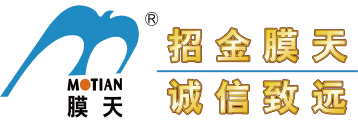
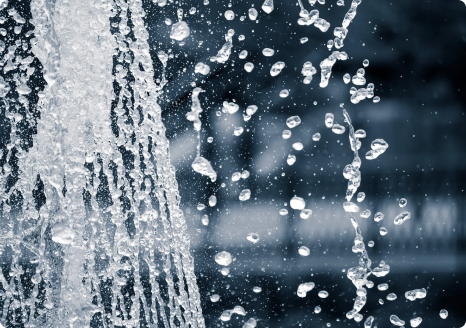
 Motian Promotional Video
Motian Promotional Video
